Let us start with the Higgs search in the diphoton decay mode by CMS (paper here). With 1.09 inverse femtobarns of data, CMS has a pretty good reach even to this very rare decay mode of the Higgs boson. Let me remind you that only a handful every thousand Higgs particles decay into two photons, in the most favourable circumstances.
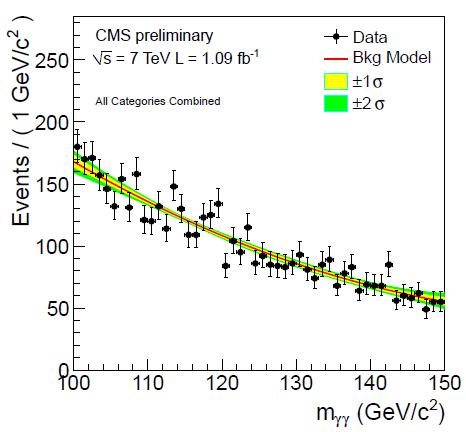 The diphoton mass spectrum is shown on the right, with a background model overlaid. Nothing sticks out -and nothing should, since one inverse femtobarns is just a bit too little data yet; a Higgs signal with a rate 10 times the SM would however show well here, as a five-bin bump or so evident above the smooth background. The limit on the cross section for Higgs production (computed in units equal to the SM cross section, such that a limit going below 1.0 at some mass point means that the particle cannot have that particular mass value) is tantalizingly close to start eroding our faith that the Higgs boson does exist, somewhere in the sought mass range. You can check this in the figure below.
The diphoton mass spectrum is shown on the right, with a background model overlaid. Nothing sticks out -and nothing should, since one inverse femtobarns is just a bit too little data yet; a Higgs signal with a rate 10 times the SM would however show well here, as a five-bin bump or so evident above the smooth background. The limit on the cross section for Higgs production (computed in units equal to the SM cross section, such that a limit going below 1.0 at some mass point means that the particle cannot have that particular mass value) is tantalizingly close to start eroding our faith that the Higgs boson does exist, somewhere in the sought mass range. You can check this in the figure below.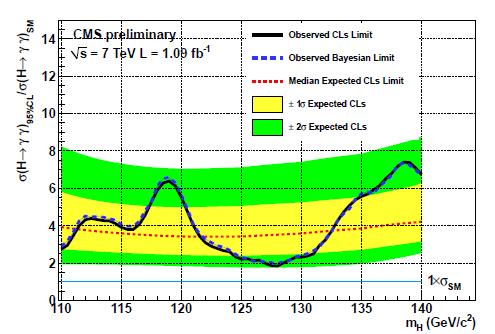
Now let us go on to the H decay into W boson pairs (paper here). Here, an exclusion of a wide mass range does occur -and yet, funnily enough things do not go as planned; the observed exclusion range is much narrower than expected, as you can check in the relative Brazil band plot below. The observed limit (using the CLs statistics and the multivariate analysis -you must read the paper to understand some detail about these things) extends from 150 to 193 GeV, but the analysis was expected to have a median exclusion power ranging from 130 to above 200 GeV! Does this mean that real Higgs bosons are contaminating the sample at some particular mass point ? We will know soon.
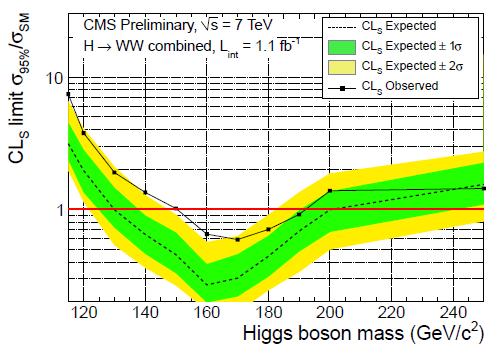
Further, let me show the results of one Higgs search performed by CMS in the ZZ final state (paper here. In this case CMS looked for two charged leptons (from one Z) plus significant missing transverse energy (from the other Z going into a pair of neutrinos -something which Z bosons do twice as frequently). The branching fraction of Higgs to Z boson pairs in the SM, together with the small branching fraction of Z bosons into leptons, makes this final state less sensitive than the one discussed above, but it is still interesting to go look, for the time being just in the high-mass region where backgrounds are very small and the sensitivity is larger. The results are shown below, again in the form of a 95% confidence-level limit on the signal cross section in unit of the Standard Model prediction. As you see, there is no region where the Higgs boson gets excluded, although the result is close to that goal in the mass range 350-400 GeV.
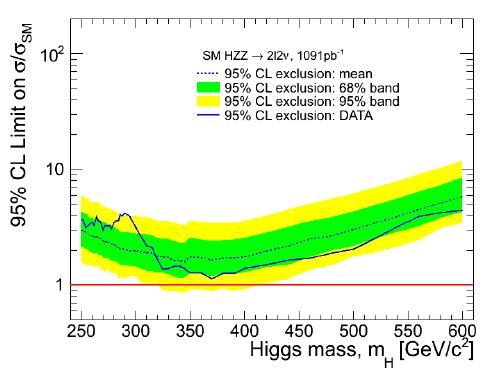
Now, if you are not too tired yet, let us see what CMS finds in another possible final state of the H->ZZ decay: the one including two charged leptons and two jets (paper here). Here, the two jets coming from a hadronic decay of one of the two Z bosons increase the possible yield significantly, since the probability of a Z decaying hadronically is 70% -over ten times higher than the probability of a decay to electron or muon pairs combined. Further, since in 40% of the cases the two quarks are heavy ones -charm or bottom-, it makes sense to consider the case when the resulting jets contain secondary vertex information; the heavy flavour hadrons produced in the heavy quark fragmentation in fact live long and can give rise to secondary vertices, plus they also decay to soft leptons. All this information can be used to identify them, strongly reducing the background from QCD Z+jets production, where the jets accompanying a leptonically-decaying Z boson are very rarely coming from heavy quarks.
The figure below shows the invariant mass of the pair of Z boson candidates (one reconstructed from the lepton pair, the other from the jet pair) observed in the data, after dividing the data into events with zero, one, or two b-tags. As you can see, a Higgs signal with three times the rate of the predicted SM Higgs (for a mass of 400 GeV chosen for illustrative purpose only) would produce almost no visible signal in the zero- and one-b-tag categories, while it would give some indication in the two-tag category.
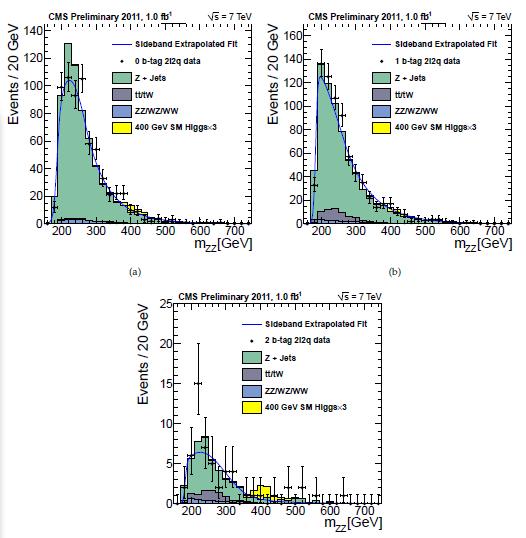
From the agreement of data and total background prediction, a 95% CL upper limit on the Higgs cross section, again computed in units of the predicted Standard Model rate, is derived as a function of the unknown mass of the Higgs boson -see below. As in the former analysis, here too there is no exclusion yet, but the limit is also close to the line at 1.0 (where an exclusion would result).
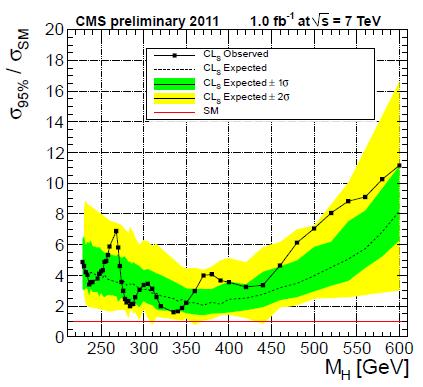
Finally, I just flash the result obtained by CMS in the search for Higgs boson decays to tau lepton pairs (paper here). Why tau pairs ? Well, because tau leptons are heavy -at 1.77 GeV they are much heavier than electrons and muons. The Higgs boson decays more readily in tau pairs than in other fermion pairs (except bottom quarks), because of its coupling proportional to the mass of the fermion. You should also know that tau leptons are much harder to detect than electrons and muons; however, they can still be seen in the large background (mainly due to fake tau leptons and to the Drell-Yan continuum). Much better than one could ever see the Higgs decay to bottom-quark pairs anyway -the latter is utterly unobservable in the huge QCD background.
To search for the Higgs in the tau-pair decay mode, CMS makes use of two different production processes: the one called "direct", whereby the Higgs is produced alone, and the one called "vector-boson fusion", whereby the Higgs is produced through the fusion of two W or two Z bosons. In this latter case, there are two forward-going hadronic jets accompanying the Higgs, so the event is better recognizable -at the expense of a smaller total rate.The search obtains a good agreement with backgrounds, and no hint is seen of the presence of signal decays. The resulting upper limit is shown below: in this case there is still the need of more data before the search becomes sensitive to the Standard Model Higgs.
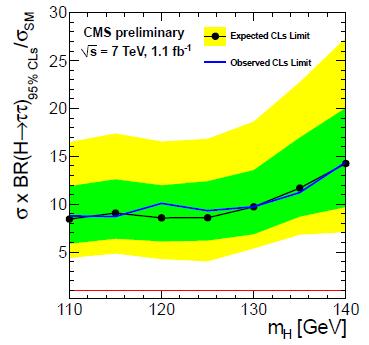
To conclude, let me say that I am eager to see a combination plot which puts together all the information above, plus other which I have been unable to report on yet. Once these results are further combined with ATLAS ones we will have a much more clear picture of where, if anywhere, the Higgs boson can still hide (hint: the 114-130 GeV region is still rather safe). Stay tuned!



Comments